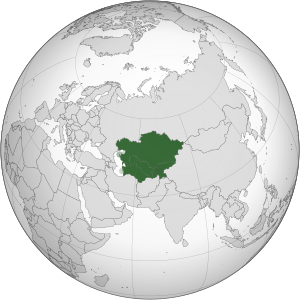Inner Asia facts for kids
Inner Asia is a huge area of land in the middle of Asia. It includes parts of what we now call Western China, Mongolia, the Russian Far East, and Siberia.
This region is mostly landlocked, meaning it doesn't touch any oceans. Inner Asia is sometimes seen as the "frontier" or edge of China. It is bordered by East Asia, which includes countries like China, Japan, and Korea.
The exact size and shape of Inner Asia have changed over time. For example, around the year 1800, it included four main areas:
- Manchuria (which is now Northeast China and a part of Russia)
- Mongolia (both Inner and Outer Mongolia)
- Xinjiang
- Tibet
These areas were controlled by the Qing dynasty of China. However, they were managed differently from other Chinese provinces. The Qing government even had a special agency called the Lifan Yuan to look after these Inner Asian regions.
Contents
What is Inner Asia?
The term Inner Asia can mean different things to different people. For example, some historians use it to describe areas that were not mainly agricultural (farm-based) civilizations. They look at how its borders changed when groups like the Huns or Mongols took over new lands.
Scholars who study the Qing dynasty often use "Inner Asia" when they talk about the Qing empire's interests and rule outside of China Proper. China Proper refers to the original parts of China where most Han Chinese people lived.
How is Inner Asia connected to other regions?
Inner Asia is often confused with or linked to other geographical terms. Let's look at some of them.
Central Asia
"Central Asia" usually means the western part of Inner Asia. This area is mostly Islamic. It includes countries like Kazakhstan, Kyrgyzstan, Tajikistan, Turkmenistan, and Uzbekistan. Sometimes, Afghanistan and Iran are also included.
It's interesting to note that some systems, like the one used by The Library of Congress, treat "Central Asia" and "Inner Asia" as meaning the same thing.
Central Eurasia
The term "Inner Asia" is well-known, but some experts think it has a problem. It suggests there's an "Outer Asia," which doesn't really exist as a defined region.
Because of this, a scholar named Denis Sinor suggested a new term: "Central Eurasia." This name highlights how important this area was for trade and connections between different continents. Sinor described Central Eurasia as the part of the huge continent of Eurasia that lies outside the borders of the big, settled civilizations. He noted that this area has gotten smaller over time as settled civilizations have grown.


